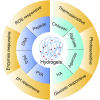Rational Design of Smart Hydrogels for Biomedical Applications
- PMID: 33614595
- PMCID: PMC7889811
- DOI: 10.3389/fchem.2020.615665
Rational Design of Smart Hydrogels for Biomedical Applications
Abstract
Hydrogels are polymeric three-dimensional network structures with high water content. Due to their superior biocompatibility and low toxicity, hydrogels play a significant role in the biomedical fields. Hydrogels are categorized by the composition from natural polymers to synthetic polymers. To meet the complicated situation in the biomedical applications, suitable host-guest supramolecular interactions are rationally selected. This review will have an introduction of hydrogel classification based on the formulation molecules, and then a discussion over the rational design of the intelligent hydrogel to the environmental stimuli such as temperature, irradiation, pH, and targeted biomolecules. Further, the applications of rationally designed smart hydrogels in the biomedical field will be presented, such as tissue repair, drug delivery, and cancer therapy. Finally, the perspectives and the challenges of smart hydrogels will be outlined.
Keywords: biomedical; hydrogel; natural polymer; responsibility; synthetic polymer.
Copyright © 2021 Zhang and Huang.
Conflict of interest statement
The authors declare that the research was conducted in the absence of any commercial or financial relationships that could be construed as a potential conflict of interest.
Figures
Similar articles
-
Natural Polymer-Based Hydrogels: From Polymer to Biomedical Applications.Pharmaceutics. 2023 Oct 23;15(10):2514. doi: 10.3390/pharmaceutics15102514. Pharmaceutics. 2023. PMID: 37896274 Free PMC article. Review.
-
Multifunctional smart hydrogels: potential in tissue engineering and cancer therapy.J Mater Chem B. 2018 Aug 7;6(29):4714-4730. doi: 10.1039/c8tb01078a. Epub 2018 Jul 4. J Mater Chem B. 2018. PMID: 32254299
-
Smart and Biomimetic 3D and 4D Printed Composite Hydrogels: Opportunities for Different Biomedical Applications.Biomedicines. 2021 Oct 26;9(11):1537. doi: 10.3390/biomedicines9111537. Biomedicines. 2021. PMID: 34829766 Free PMC article. Review.
-
Recent Advances in Host-Guest Supramolecular Hydrogels for Biomedical Applications.Chem Asian J. 2022 Sep 14;17(18):e202200608. doi: 10.1002/asia.202200608. Epub 2022 Aug 5. Chem Asian J. 2022. PMID: 35866560 Review.
-
Natural Polymer-based Stimuli-responsive Hydrogels.Curr Med Chem. 2020;27(16):2631-2657. doi: 10.2174/0929867326666191122144916. Curr Med Chem. 2020. PMID: 31755377 Review.
Cited by
-
Application of stimuli-responsive hydrogel in brain disease treatment.Front Bioeng Biotechnol. 2024 Jul 18;12:1450267. doi: 10.3389/fbioe.2024.1450267. eCollection 2024. Front Bioeng Biotechnol. 2024. PMID: 39091971 Free PMC article. Review.
-
Stimuli-Responsive Dual Cross-Linked N-Carboxyethylchitosan Hydrogels with Tunable Dissolution Rate.Gels. 2021 Oct 29;7(4):188. doi: 10.3390/gels7040188. Gels. 2021. PMID: 34842662 Free PMC article.
-
The Role of Extracellular Matrix (ECM) Adhesion Motifs in Functionalised Hydrogels.Molecules. 2023 Jun 7;28(12):4616. doi: 10.3390/molecules28124616. Molecules. 2023. PMID: 37375171 Free PMC article. Review.
-
Development and Applications of PLGA Hydrogels for Sustained Delivery of Therapeutic Agents.Gels. 2024 Jul 26;10(8):497. doi: 10.3390/gels10080497. Gels. 2024. PMID: 39195026 Free PMC article. Review.
-
Frontier and hot topics in the application of hydrogel in the biomedical field: a bibliometric analysis based on CiteSpace.J Biol Eng. 2024 Jul 23;18(1):40. doi: 10.1186/s13036-024-00435-2. J Biol Eng. 2024. PMID: 39044254 Free PMC article.
References
Publication types
LinkOut - more resources
Full Text Sources
Other Literature Sources


